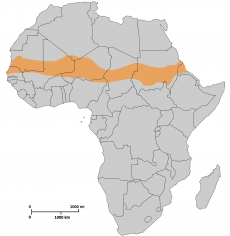

The Sahel – Water Scarcity
The impacts of water scarcity
The Sahel region has a fragile environment and slight changes in rainfall often leads to humanitarian crises: high water insecurity leads to food insecurity and therefore famines which regularly occur and are disastrous for nomads and subsistence farmers- more than 10.3 million people in the Sahel are food insecure.
The decade-long drought has gradually exhausted local emergency resources so that each humanitarian crisis is worse than the previous one because it is harder for local communities to continually cope with famines. This issue is worst in Mali, Mauritania, Burkina Faso, Chad and Niger.
The lack of rain causes plants to dry out resulting in bush fires which destroy crops and make it harder to find wood for fuel and grasses for the livestock.
In 2012, more than 17 million people were facing starvation in West Africa’s Sahel region. This was caused by the combination of little rainfall in 2011, low food supply, high food prices, and pressure to provide food and water for the 300,000 refugees from the recent conflicts in Mali and Niger.
The Impacts of Water Scarcity in Mali
The extended drought has meant that the river basins which supply the Sahel simply do not have enough water to meet the demand for it. An example of this is the Malian village of Guidio, Guidio is situated on the shore of Lake Debo and it once had a plentiful supply of water. However, this is no longer the case, water is increasingly becoming a concern for the inhabitants of Guidio, the river levels have dropped drastically, they can’t grow crops where they used to be able to grow anything, and once fertile land has turned to dust. Guidio is a small example of the problem which is being felt all along the Niger.
There has been an increased level of emigration since the start of the dry period in 1970 because there has simply not been enough food. People realised that if they went to work in another country like France, they could send the money they earned to their families in Mali.
In 2012, the political instability and the rebellion in northern Mali led to a food and security crisis, following low rainfall which caused the harvest to fail. By February, the prices of sorghum and millet had increased drastically due to the high demand and the fact that food supply and distribution was reduced by the conflict. The UN estimated that 1.6million Malians would be short of food in 2012. The dwindling food supply problem has been worsened by 230,000 refugees who were internally displaced by the conflict in the north.
Adaptations to Water Scarcity in the Sahel
Burkina Faso
They build stone terraces and walls to protect crops from flooding and soil erosion by the wind.
Planting trees to help reduce the risk of desertification and flooding.
They build demi-lunes (holes around plants) so that when it rains the water stays in the demi-lune for a few extra days, nourishing the crops.
A dam has been built so that they get more water than they get from wells and can also use the water to irrigate crops.
Organic pesticides and fertilisers which are safe for bees and are used to help crops grow.
Solar power helps to reduce the need for deforestation and provides communities with sustainable power and light at night. Solar power is 10 times more economic than oil.
Water pumps can be used to access fresh, clean more reliable ground water supply which helps to reduce the effect that the drought is having on communities.
https://simple.wikipedia.org/wiki/Sahel

0 Comment:
Be the first one to comment on this article.